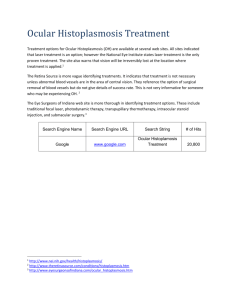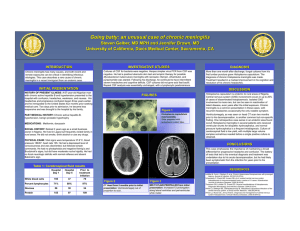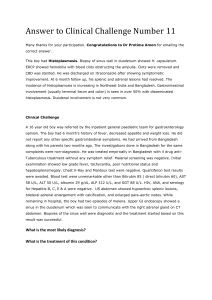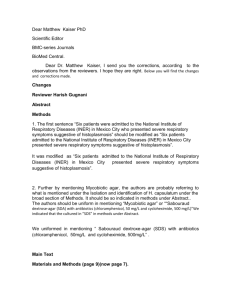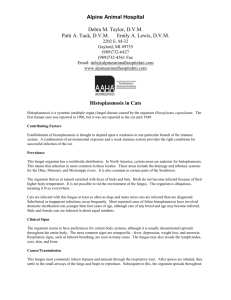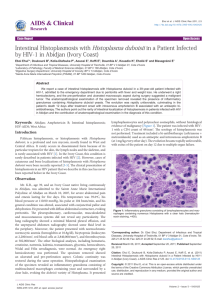JOHNS HOPKINS
advertisement
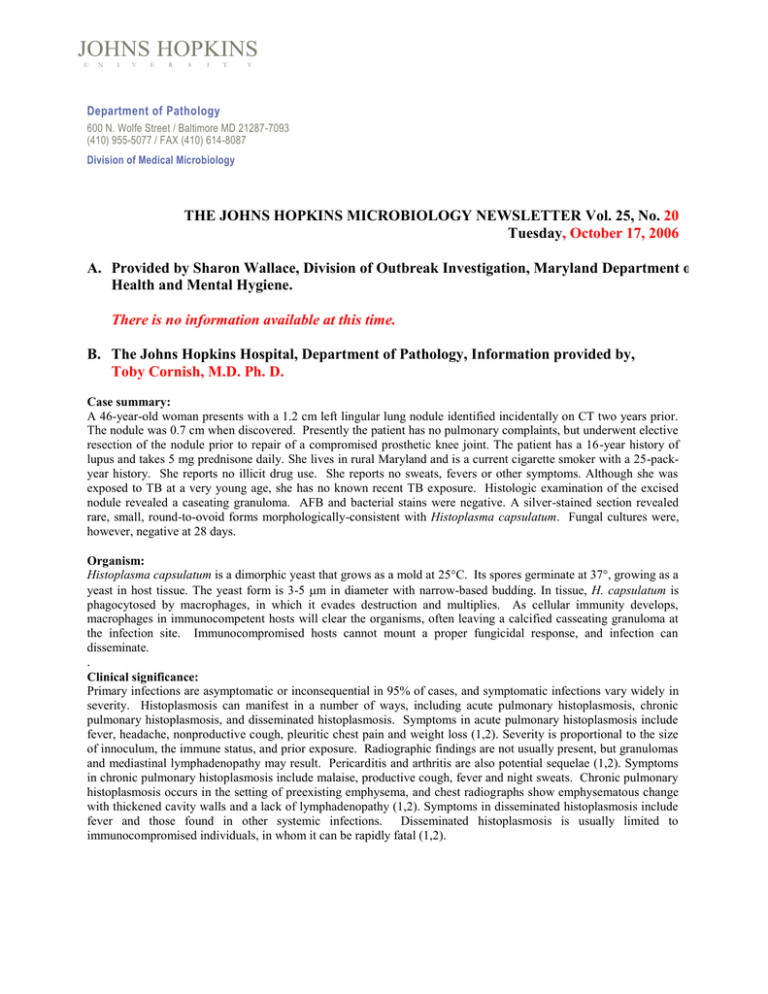
JOHNS HOPKINS U N I V E R S I T Y Department of Pathology 600 N. Wolfe Street / Baltimore MD 21287-7093 (410) 955-5077 / FAX (410) 614-8087 Division of Medical Microbiology THE JOHNS HOPKINS MICROBIOLOGY NEWSLETTER Vol. 25, No. 20 Tuesday, October 17, 2006 A. Provided by Sharon Wallace, Division of Outbreak Investigation, Maryland Department of Health and Mental Hygiene. There is no information available at this time. B. The Johns Hopkins Hospital, Department of Pathology, Information provided by, Toby Cornish, M.D. Ph. D. Case summary: A 46-year-old woman presents with a 1.2 cm left lingular lung nodule identified incidentally on CT two years prior. The nodule was 0.7 cm when discovered. Presently the patient has no pulmonary complaints, but underwent elective resection of the nodule prior to repair of a compromised prosthetic knee joint. The patient has a 16-year history of lupus and takes 5 mg prednisone daily. She lives in rural Maryland and is a current cigarette smoker with a 25-packyear history. She reports no illicit drug use. She reports no sweats, fevers or other symptoms. Although she was exposed to TB at a very young age, she has no known recent TB exposure. Histologic examination of the excised nodule revealed a caseating granuloma. AFB and bacterial stains were negative. A silver-stained section revealed rare, small, round-to-ovoid forms morphologically-consistent with Histoplasma capsulatum. Fungal cultures were, however, negative at 28 days. Organism: Histoplasma capsulatum is a dimorphic yeast that grows as a mold at 25°C. Its spores germinate at 37°, growing as a yeast in host tissue. The yeast form is 3-5 m in diameter with narrow-based budding. In tissue, H. capsulatum is phagocytosed by macrophages, in which it evades destruction and multiplies. As cellular immunity develops, macrophages in immunocompetent hosts will clear the organisms, often leaving a calcified casseating granuloma at the infection site. Immunocompromised hosts cannot mount a proper fungicidal response, and infection can disseminate. . Clinical significance: Primary infections are asymptomatic or inconsequential in 95% of cases, and symptomatic infections vary widely in severity. Histoplasmosis can manifest in a number of ways, including acute pulmonary histoplasmosis, chronic pulmonary histoplasmosis, and disseminated histoplasmosis. Symptoms in acute pulmonary histoplasmosis include fever, headache, nonproductive cough, pleuritic chest pain and weight loss (1,2). Severity is proportional to the size of innoculum, the immune status, and prior exposure. Radiographic findings are not usually present, but granulomas and mediastinal lymphadenopathy may result. Pericarditis and arthritis are also potential sequelae (1,2). Symptoms in chronic pulmonary histoplasmosis include malaise, productive cough, fever and night sweats. Chronic pulmonary histoplasmosis occurs in the setting of preexisting emphysema, and chest radiographs show emphysematous change with thickened cavity walls and a lack of lymphadenopathy (1,2). Symptoms in disseminated histoplasmosis include fever and those found in other systemic infections. Disseminated histoplasmosis is usually limited to immunocompromised individuals, in whom it can be rapidly fatal (1,2). Epidemiology: H. capsulatum is endemic in the Ohio and Mississippi river valleys and is also present other river valleys of North and Central America between latitudes 45° north and 30° south (2). In some regions, up to 90% of the population have a positive skin reactivity test (3). In the US, 40 million people are infected with H. capsulatum and there are up to 500,000 new cases each year (1). Soil contaminated with bat or bird feces makes an excellent substrate for growth, and disruption of soil can significantly increase airborne spores. Laboratory diagnosis: Culture of H. capsulatum is considered the gold standard, but can require a 2-to-4 week incubation, making it impractical for acute, life-threatening infections. Culture has a sensitivity of 85% in disseminated histoplasmosis, 85% in chronic pulmonary histoplasmosis, and 15% in self-limited manifestations (acute pulmonary histoplasmosis, rheumatologic manifestations, and pericarditis) (1,4). In cases were there is a strong clinical suspicion of H. capsulatum, the JHH mycology lab may be contacted directly so that negative cultures can be maintained past 4 weeks (5). For infections of greater than 2-to-6 weeks in duration, serological detection of antibodies provides rapid detection. However, antibodies may not be detectable in immunocompromised individuals. Serology has a sensitivity of 71% in disseminated histoplasmosis, 100% in chronic pulmonary histoplasmosis, and 98% in self-limited manifestations (1,4). Serological false positives may result from other fungal infections, including blastomycosis and aspergillosis (3). Direct fungal staining of tissue or blood is another rapid means of diagnosis, but suffers from poor sensitivity. Staining has a sensitivity of 43% in disseminated histoplasmosis, 17% in chronic pulmonary histoplasmosis, and 9% in self-limited manifestations (1,4). Identification relies on the morphological characteristics of the yeast form and C. glabrata, P. marneffei, Leishmania, P. carinii, and staining artifacts can produce false positives (3). Antigen detection in urine is the most sensitive test for disseminated histoplasmosis, but may be less useful in chronic infections. Urine antigen can also be followed to monitor therapy. Antigen detection has a sensitivity of 92% in disseminated histoplasmosis, 21% in chronic pulmonary histoplasmosis, and 39% in self-limited manifestations (1,4). Treatment: Treatment varies with the nature and severity of the infection. Amphotericin B, followed by long-term itraconazole is recommended for severe cases of histoplasmosis. Long-term itraconazole alone is recommended for moderate and mild cases. Corticosteroids and/or pericardial drainage is recommended for severe pericarditis, and NSAIDs are recommended for mild pericarditis. NSAIDs are recommended for rheumatologic manifestations (1). References: (1) Kurowski R, Ostapchuk M. Overview of histoplasmosis. Am Fam Physician. 2002 Dec 15;66(12):2247-52. (2) Chang RC, Susanto I. Histoplasmosis. E-Medicine, http://www.emedicine.com/med/topic1021.htm. Last updated 9/19/2005. Accessed 10/12/2006. (3) Wheat JL. Current diagnosis of histoplasmosis. Trends Microbiol. 2003 Oct;11(10):488-94. (4) Wheat JL. Histoplasmosis. Experience during outbreaks in Indianapolis and review of the literature. Medicine (Baltimore). 1997 Sep;76(5):339-54. (5) Merz WG, personal communication.
